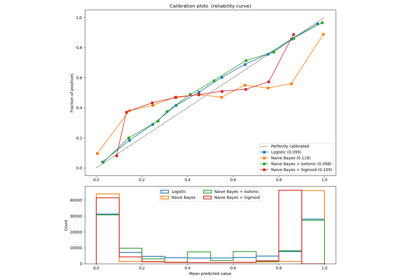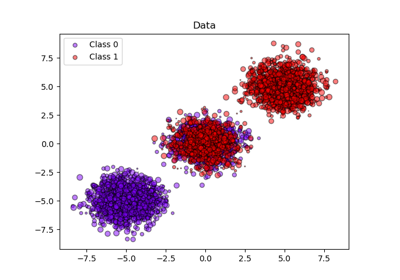sklearn.calibration.CalibratedClassifierCV¶
-
class
sklearn.calibration.CalibratedClassifierCV(base_estimator=None, *, method='sigmoid', cv=None)[source]¶ Probability calibration with isotonic regression or logistic regression.
The calibration is based on the decision_function method of the
base_estimatorif it exists, else on predict_proba.Read more in the User Guide.
- Parameters
- base_estimatorinstance BaseEstimator
The classifier whose output need to be calibrated to provide more accurate
predict_probaoutputs.- method‘sigmoid’ or ‘isotonic’
The method to use for calibration. Can be ‘sigmoid’ which corresponds to Platt’s method (i.e. a logistic regression model) or ‘isotonic’ which is a non-parametric approach. It is not advised to use isotonic calibration with too few calibration samples
(<<1000)since it tends to overfit.- cvinteger, cross-validation generator, iterable or “prefit”, optional
Determines the cross-validation splitting strategy. Possible inputs for cv are:
None, to use the default 5-fold cross-validation,
integer, to specify the number of folds.
An iterable yielding (train, test) splits as arrays of indices.
For integer/None inputs, if
yis binary or multiclass,sklearn.model_selection.StratifiedKFoldis used. Ifyis neither binary nor multiclass,sklearn.model_selection.KFoldis used.Refer User Guide for the various cross-validation strategies that can be used here.
If “prefit” is passed, it is assumed that
base_estimatorhas been fitted already and all data is used for calibration.Changed in version 0.22:
cvdefault value if None changed from 3-fold to 5-fold.
- Attributes
- classes_array, shape (n_classes)
The class labels.
- calibrated_classifiers_list (len() equal to cv or 1 if cv == “prefit”)
The list of calibrated classifiers, one for each cross-validation fold, which has been fitted on all but the validation fold and calibrated on the validation fold.
References
- 1
Obtaining calibrated probability estimates from decision trees and naive Bayesian classifiers, B. Zadrozny & C. Elkan, ICML 2001
- 2
Transforming Classifier Scores into Accurate Multiclass Probability Estimates, B. Zadrozny & C. Elkan, (KDD 2002)
- 3
Probabilistic Outputs for Support Vector Machines and Comparisons to Regularized Likelihood Methods, J. Platt, (1999)
- 4
Predicting Good Probabilities with Supervised Learning, A. Niculescu-Mizil & R. Caruana, ICML 2005
Methods
fit(X, y[, sample_weight])Fit the calibrated model
get_params([deep])Get parameters for this estimator.
predict(X)Predict the target of new samples.
Posterior probabilities of classification
score(X, y[, sample_weight])Return the mean accuracy on the given test data and labels.
set_params(**params)Set the parameters of this estimator.
-
__init__(base_estimator=None, *, method='sigmoid', cv=None)[source]¶ Initialize self. See help(type(self)) for accurate signature.
-
fit(X, y, sample_weight=None)[source]¶ Fit the calibrated model
- Parameters
- Xarray-like, shape (n_samples, n_features)
Training data.
- yarray-like, shape (n_samples,)
Target values.
- sample_weightarray-like of shape (n_samples,), default=None
Sample weights. If None, then samples are equally weighted.
- Returns
- selfobject
Returns an instance of self.
-
get_params(deep=True)[source]¶ Get parameters for this estimator.
- Parameters
- deepbool, default=True
If True, will return the parameters for this estimator and contained subobjects that are estimators.
- Returns
- paramsmapping of string to any
Parameter names mapped to their values.
-
predict(X)[source]¶ Predict the target of new samples. The predicted class is the class that has the highest probability, and can thus be different from the prediction of the uncalibrated classifier.
- Parameters
- Xarray-like, shape (n_samples, n_features)
The samples.
- Returns
- Carray, shape (n_samples,)
The predicted class.
-
predict_proba(X)[source]¶ Posterior probabilities of classification
This function returns posterior probabilities of classification according to each class on an array of test vectors X.
- Parameters
- Xarray-like, shape (n_samples, n_features)
The samples.
- Returns
- Carray, shape (n_samples, n_classes)
The predicted probas.
-
score(X, y, sample_weight=None)[source]¶ Return the mean accuracy on the given test data and labels.
In multi-label classification, this is the subset accuracy which is a harsh metric since you require for each sample that each label set be correctly predicted.
- Parameters
- Xarray-like of shape (n_samples, n_features)
Test samples.
- yarray-like of shape (n_samples,) or (n_samples, n_outputs)
True labels for X.
- sample_weightarray-like of shape (n_samples,), default=None
Sample weights.
- Returns
- scorefloat
Mean accuracy of self.predict(X) wrt. y.
-
set_params(**params)[source]¶ Set the parameters of this estimator.
The method works on simple estimators as well as on nested objects (such as pipelines). The latter have parameters of the form
<component>__<parameter>so that it’s possible to update each component of a nested object.- Parameters
- **paramsdict
Estimator parameters.
- Returns
- selfobject
Estimator instance.



